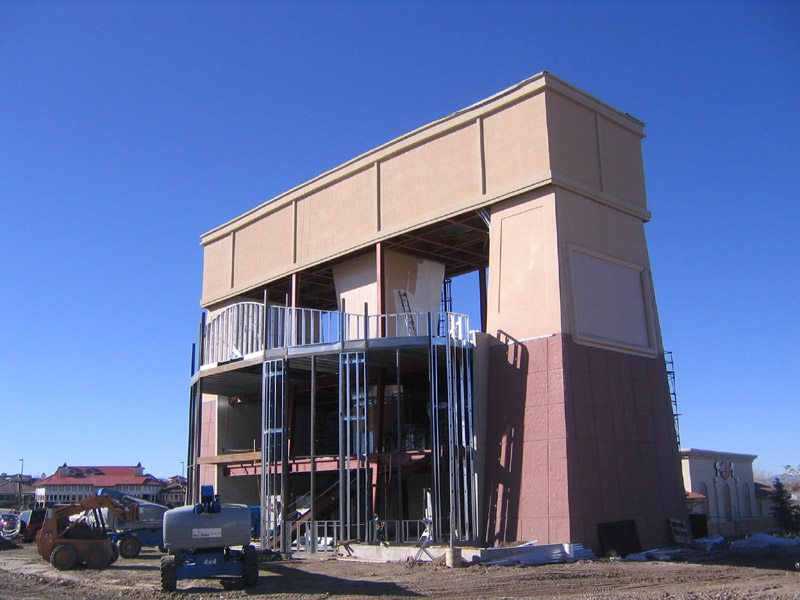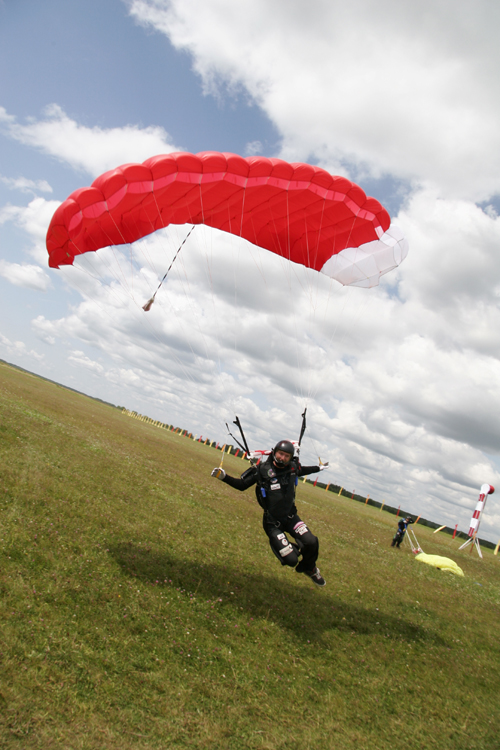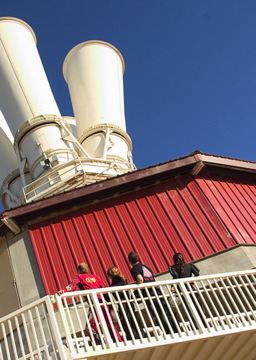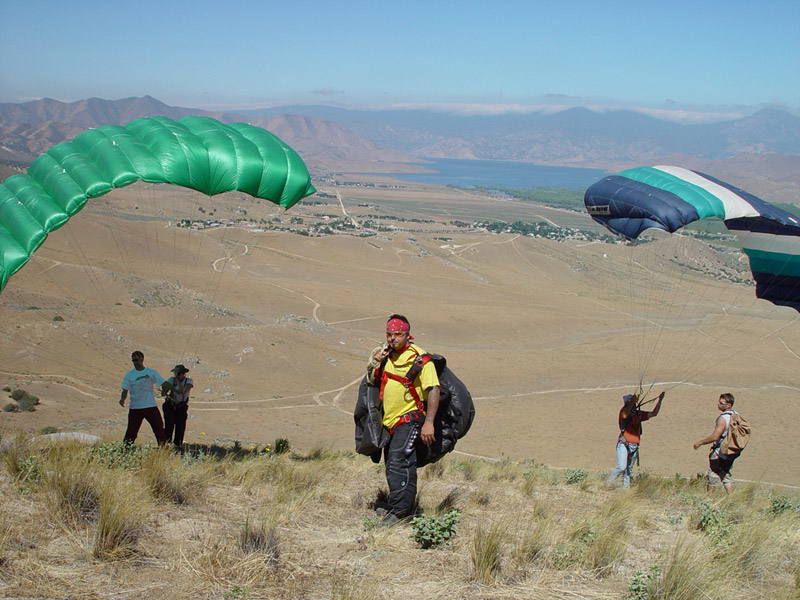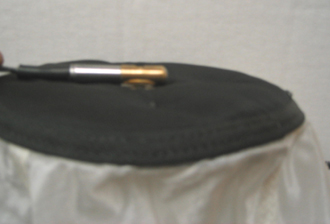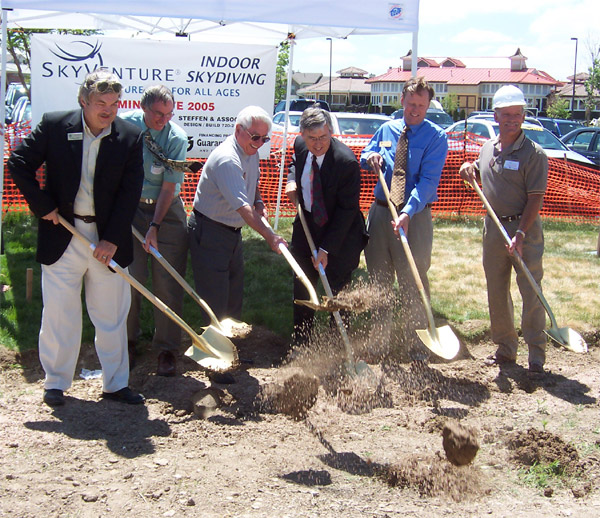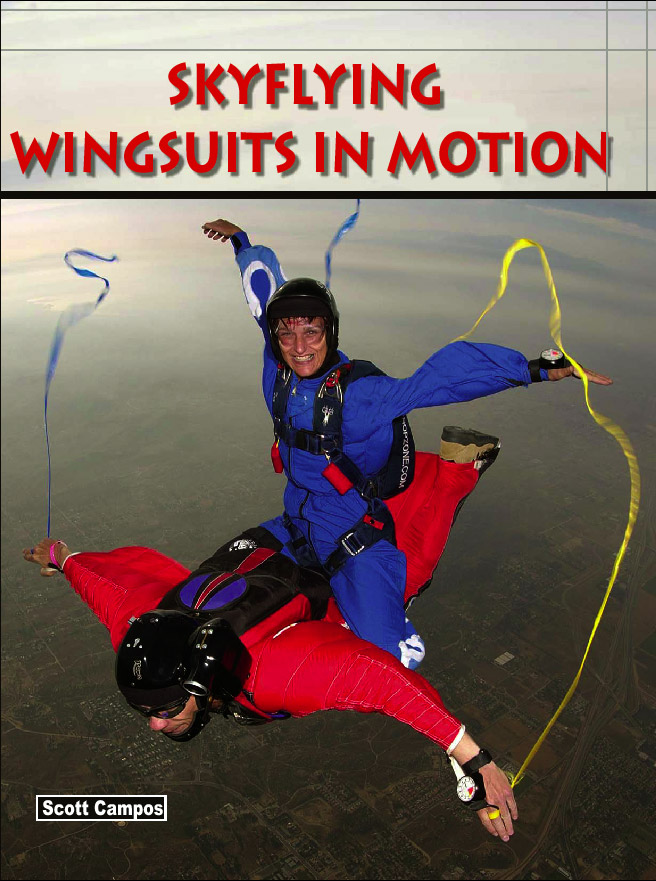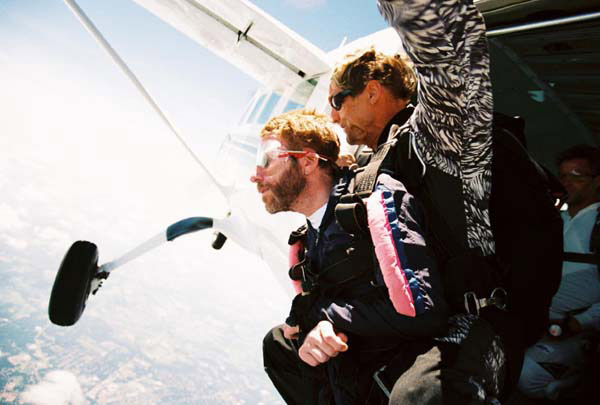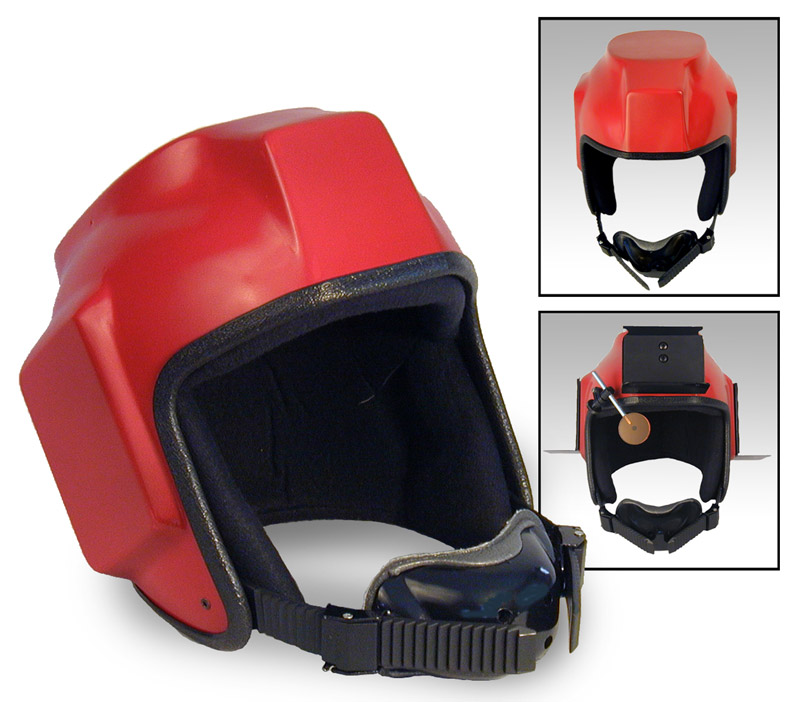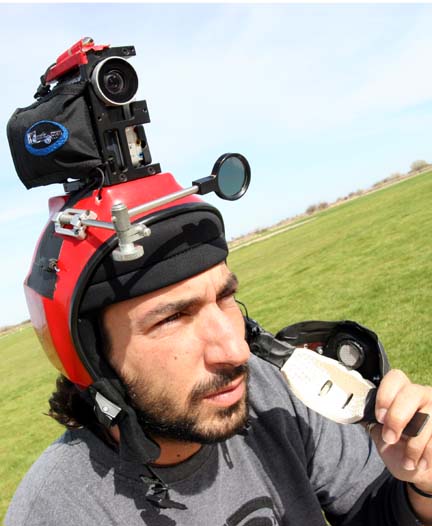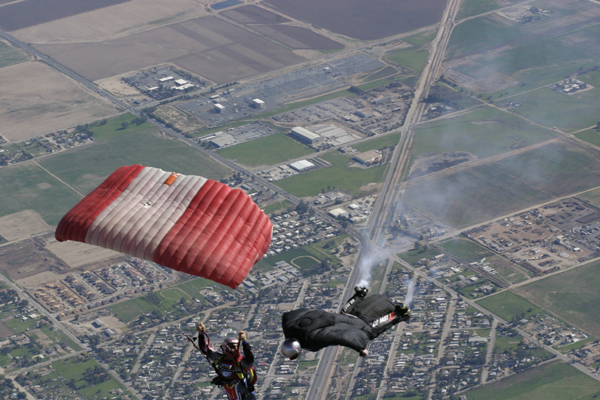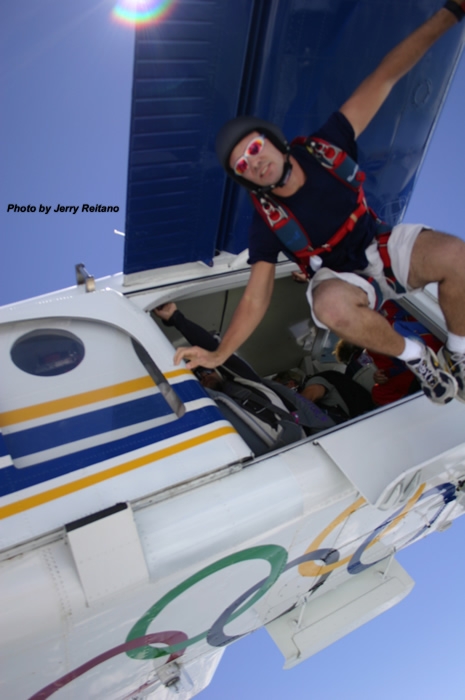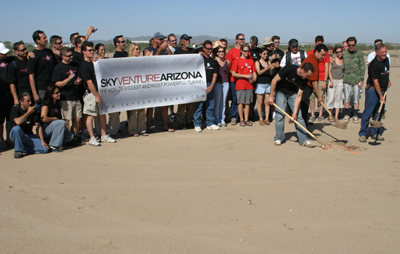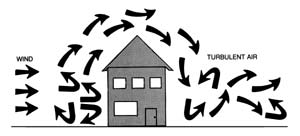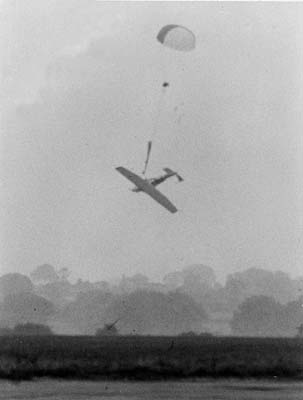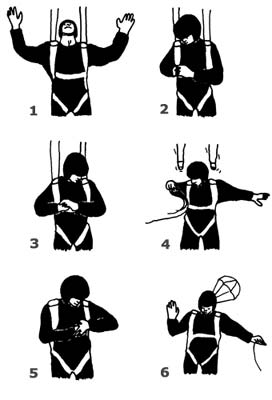Search the Community
Showing results for tags 'news'.
Found 523 results
-
I'm sure by now you have heard the buzz in the Skydiving community about the newest SkyVenture wind tunnel being built in Lone Tree, Colorado. Well, the buzz is true; finally Colorado will have its very own indoor flight chamber. All of SkyVenture's latest technology wrapped in a single spectacular package and placed in the middle of The Entertainment District next to Park Meadows Mall located at 9230 Park Meadows Drive, in Lone Tree, Colorado. SkyVenture Colorado tunnel has all the latest improvements in design. The first thing you'll notice is the building is a single fully contained facility. Behind the unique architecture you will find a massive amount of very sophisticated components making up what is referred to as a "re-circulating tunnel". This technology has many advantages. By re-circulating the air they can maintain a very comfortable 70 degrees in the tunnel even when it is snowing outside. By virtually eliminating all influence from outside wind gusts and channeling the air early on it gives the ultimate smooth as silk air. Combining extremely tight tolerances on aerodynamic design and 1200 hp they have created the finest, smoothest 160mph+ air available in the industry. SkyVenture Colorado LLC is a private Colorado based company formed to own and operate the most technologically advance and realistic skydiving simulator in the world. A group of investors headed up by Norm Rosendale are not new to the world of entertainment. Norm was involved in the SkyCoaster amusement ride business and served on the Board for Sky Fun 1. He has flown hang gliders for over 25 years and owned and operated his own hang gliding business. Norm's mission is to create a comfortable atmosphere for the skydivers and non-skydivers to relax and interact with each other and share their dreams and experiences of flight. "If we all don't walk away with a smile on our face then we are not doing it right". Construction is going very well for a late December early January opening. Please sign up for e-mail updates or buy now and make your reservations to be one of the first fliers at www.SkyVentureColorado.com
-
The Aerodyne Mamba is the ultimate high performance 9 cell elliptical designed with the more experienced pilot in mind that isn't looking for all the costs and pack volume issues associated with cross braced canopies. It is intended to compete with canopies like the Katana and Crossfire. Edward "Bushman" Anderson, President of Aerodyne Research, describes how the Mamba came into existence: "This product is the result of 2 years of continued Research & Development and test jumping, with the final version of prototype being test jumped in cooperation with the Norwegian 4-way team Arcteryx. The team has approximately 1500 jumps on the Katana and therefore had a good platform to relate to, whilst evaluating the Mamba." With a planform factor of 22.1 and an aspect ratio of 2.7:1 the Mamba is one of the most elliptical wings on the market today. As a comparison, the Pilot has a planform factor of 6.6 and the Vision 14.7. Despite its aggressive taper, the Mamba sports unparalleled openings and provides the jumper with a smooth controlled snivel & maximum forgiveness during inflation. It is extremely responsive to toggle input. One of the most impressive features of the Mamba is the glide ratio. Recent tests against other high performance canopies show that the Mamba has a definite advantage in this performance arena. With the Mamba a jumper will increase the ability to get back from long spots and have the absolute longest swoop landings ever experienced under a non cross braced wing. The Mamba has light toggle and riser pressure, allowing the jumper to explore all avenues of available control input and to maximize the performance of this new wing. By utilizing the light front riser pressure one can continue to increase both the speed with steep but controlled dives. The flare on the Mamba is powerful and easy to read, leaving you with total control of pitch angle. "From the moment you start your flare you will easily be able to gauge your distance and landing speed. Experienced canopy pilots will find that the Mamba is easy to land while maximizing their swoop distance and control.", so reports Ole Petter Hjelle, team captain of Arcteryx. "Our team member Tore Buer has already flown the Mamba during swoop competitions and put respectable scores on the board!" Design Features Fully Elliptical Planform - Provides phenomenal flight performance and landings. Pre Shaped Nose - Improved inflation and aerodynamics. Zero Porosity Fabric - Provides increased durability & longevity 700 lb HMA Line - Provides exacting tolerance on line trims. Aspect Ratio - 2.7:1 Planform Factor - 22.1 Available Sizes90, 96, 104, 111, 117, 124, 132, 140 and 150 sq ft. The retail price of the Mamba is fixed at $ 1999 and we are taking orders now. Aerodyne International
-
ELOY (September 14, 2005) - Skydive Arizona, an Arizona-based company that is one of the world's largest drop zones and skydiving centers, announced that it has filed a lawsuit against Cary Quattrochi and Ben Butler, the principals in 1-800-SKY-RIDE. The complaint filed in federal district court in Arizona alleges violations of federal law prohibiting false designations of origin, false or misleading descriptions of fact, and false or misleading representations of fact in commercial advertising. According to the complaint, the named defendants misrepresent the nature, characteristics, qualities, and geographic origin of their services and commercial activities. The complaint also alleges claims of consumer deception, unfair competition, and trademark infringement. The complaint alleges that the defendants have more than 900 websites purporting to offer skydives and related services at locations in Arizona and elsewhere, which are allegedly used in a common plan or scheme to deceive consumers and to perpetuate a scam on the public. The defendants are alleged to have a website that misrepresents the defendants as "Arizona Skydiving," "Skydiving Arizona," and as the "Skydiving Arizona Center" in the State of Arizona. According to the complaint filed by Skydive Arizona, the 1800Skyride represent that their facility at "Skydiving Arizona" is "the busiest skydive center serving Arizona," that they "run multiple turbine aircraft," and that they have "multiple large screen TV's in our hanger for you to use and watch your video for the first time," when in fact the defendants have no such aircraft, hanger, large screen TV's, or skydiving center in Arizona. Skyride allegedly have websites for fictitious skydiving centers in Phoenix, Tempe, Scottsdale, Mesa, Glendale, Gilbert, Yuma, Flagstaff, Chandler, Peoria, and Tucson, which are alleged to falsely represent that defendants have a skydiving center at each such location. Skydive Arizona has alleged that the defendants have one or more websites that include photographs of Skydive Arizona's aircraft which are misrepresented to be photographs showing defendants' aircraft. The complaint also alleges that many of the defendants' websites include a photograph of skydivers taken at Skydive Arizona, which is allegedly represented to be a photograph of the defendants' experienced staff of instructors, and the same photograph is allegedly misrepresented as the staff at defendants' fictitious skydiving centers in Green Bay, Wisconsin; Springfield, Illinois; Nashville, Tennessee; and Atlanta, Georgia. The complaint alleges a nationwide scheme to mislead consumers with websites for fictitious skydiving centers throughout the United States, while it is alleged that the defendants have no such physical facilities, instructors, or aircraft at the locations represented on the websites. Consumers are allegedly provided with a toll-free number to call to make reservations to skydive at the defendants' fictitious skydiving centers, and the telephone calls are allegedly routed to a telemarketing center in Georgia. The complaint also alleges that the defendants on at least one occasion fraudulently diverted telephone calls from a legitimate skydiving center to the defendants' telemarketing center after the owner of the business died, and while the decedent's widow and children were attempting to sell the business. Also named as defendants in the suit are the Atlanta Skydiving Center, Casc Inc., 1-800-SKY-RIDE, and 1800SkyRide.com. Skydive Arizona is represented by Sid Leach of the Phoenix law firm of Snell & Wilmer, L.L.P. About Skydive Arizona, Inc. Skydive Arizona has grown from a business established in 1978 by Larry and Liliane Hill, at a time when they owned a single Cessna 182. Operating under the name "Skydive Arizona" since 1986, the business has grown significantly, and is now recognized as the world's largest skydiving center. Skydive Arizona tallies over 150,000 jumps annually at its facility in Eloy, Arizona. Skydive Arizona provides state-of-the-art training, world-renowned instructors and staff, pilots, videographers and coaches, and has established an international reputation in the skydiving industry. For further information, contact Betsy Barnhouse at Skydive Arizona, 4900 Taylor Road, Eloy, Arizona 85231; telephone: (520) 466-0493. Also see: The SkyRide Virtual Network Scam What can we do about Skyride?
-
All the employees of SkyVenture Arizona are delighted to announce that the world’s largest indoor wind tunnel is now officially open for business! We believe the moment you enter the flight chamber for the first time you will agree that this fantastic facility was worth the wait! Whether you come as an individual or part of a team, we know that this new tunnel will meet and exceed all of your expectations. With the totally round 14 foot diameter flight chamber, four quiet and powerful electric engines, and new airflow design, we are confident that you will find this new tunnel to be the best training aid available anywhere! To mark our opening, for a limited time, we have special low hourly rates for you! Because we are a part of the Skydive Arizona family (www.Skydiveaz.com) we have the best coaching for every skydiving need. Our great group of newly trained tunnel instructors is always here to assist you as well as instructors from the Arizona Training Center. Members of Skydive Arizona's World Championship team, Arizona Airspeed, (www.Airspeed.org) will also be holding tunnel camps, skills camps, team and individual world class coaching as well! In addition, Airspeed will be holding weekly tunnel coaching sessions throughout the year (more on those in our next email). Whether your goal is to become a better and safer skydiver, to have some fun, to compete, or to become a world champion, the wind tunnel at Skyventure Arizona is another great reason to come to the sun. Heck, now you don't even need that! We look forward to flying with you, soon! For more information please visit our web site, www.Skyventureaz.com, or call us at 1-888-BODYFLY or 520-466-4640.
-
The Ground Launch CenterTM has implemented a new program designed to teach non-skydivers the art of canopy piloting. The center is a playground for experienced pilots, and provides a solid training environment for all levels of canopy pilots. The GLC offers advanced canopy control, Blade running activities and canopy piloting training to low time skydivers. Jim Slaton, who started the center, has put much of his focus into creating a solid training program that can even teach non-skydivers how to fly a parachute before they make their first solo skydive! Jim believes ground launching will play a huge role in the future development of canopy pilots and canopy piloting (a.k.a swooping) as a sport. More on that later… After a full season of development at the center Jim finally accepted his first non-skydiver into the program. Why would a non-skydiver want to learn canopy piloting you ask? The first student pilot was a 49-year-old male from the Northeast U.S. that had made a few tandem skydives over the last couple of years but was terrified of the canopy flight. He had flown in the wind tunnel in Orlando, and was comfortable with his freefall abilities, but not his actions under an open parachute. He read about the Ground Launch Center™ in Skydiving magazine and contacted the center for training. Jim had just finished the "Zero Intro" program for the center, which was designed to teach non-skydivers canopy piloting through tandem progression and a series of hovering flights. The Zero Intro training begins with an introduction to the modern ram-air parachute and it's design parameters. The ground training includes harness training, kiting and basic canopy handling. The student learns kiting and how to fly the parachute overhead using all of the controls. The student is then placed in a "saddle" area on the training hill where the student is allowed to kite the canopy overhead and hover above the ground tethered to the ground instructor. The student then conducts a series of tandem flights with the instructor to learn the basics of parachute flying. Through tandem progression the instructor demonstrates flat turns, stalls, riser turns, harness turns and more. The student is allowed to hold the controls with the instructor so they can feel the timing and speed of all inputs made during each flight and landing. The student eventually graduates to the point where the instructor gives the student full control of the toggles and talks the student through the pattern, set up and landing while flying as a tandem pair. When the student can fly all aspects of the pattern, demonstrate full control of the parachute and land the tandem on a designated target several times they are allowed to make their first solo flight. The student makes their first solo fight with the same Set 400 parachute they were flying during the tandem progression phase. They are taken back to a small training hill with a gentle slope that allows for very little altitude and flight time. The student and instructor are both equipped with a voice activated radio. The instructor assists the student through the launch and guides them through a short flight and into the landing area. The student continues with these low level flights until they demonstrate full control of the parachute and land (standing up) on a designated target several times. The student then graduates from a Set 400 to a 240 square foot parachute and conducts the same set of maneuvers as before. When the student has demonstrated proficiency with the 240 on the training hill, they are moved up to the 600ft launch site. When they prove proficiency on the 600ft hill they are moved up to the 800ft hill where they have enough flight time to perform a full set up, approach and landing, solo. In the case of our 49 year old male, he made 13 tandem launches with the instructor followed by 12 solo flights under a 240 in three days of training at the center. After the tandem progression phase of the training he was able to run a pattern and perform a stand up landing in the designated area on every solo flight! After successful completion of the GLC's "Zero Intro" program our 49-year-old male enrolled into the AFF course and is soon to become a licensed skydiver. The center is not only breeding better canopy pilots for skydiving, they are breeding a new generation of canopy pilots that are pushing the very limits of the ram-air parachute. For the first time ever, other professional athletes and aerial enthusiasts can get involved with parachuting without some of the restrictions that come along with skydiving. We are not talking about Paragliding (also conducted at the GLC) but more like "speed gliding" with the appeal of Swooping and BladerunningTM. If you want to see some of what we are talking about check out the Pro Tour's latest DVD entitled GRAVITY PILOTS "Canopy Piloting Revolution" at www.gravitypilots.com or find more info on the Ground Launch Center™ at www.canopypiloting.com
-
After Mirage Systems released the Product Service Bulletin in December of 2004 our customers have been contacting us regarding the cosmetic appearance of our container after the cutter modification had been performed. We have had a great amount of feedback informing us that the reserve top flap that covers the reserve pin was gapping and bulging considerably after their riggers had performed the modification. The cutter being located on top of the pilot chute does require some additional tips and tricks to be done during the pack job to alleviate this problem. If the rigger manages bulk properly on the pack job then there is no noticeable difference then before the modification. But we at Mirage Systems want to design the highest quality, most rigger friendly, and best looking container on the market. That is why we have listened to our customers and have designed a new reserve pilot chute cap that addresses this issue. How it works Figure 1 is of a Cypres cutter resting on top of the reserve pilot chute as mandated by our service bulletin. The Cypres cutter is between the pilot chute cap and the number 3 reserve flap after packed. With the cutter resting on top of the pilot chute cap it does not allow the number 3 flap to rest flush upon the pilot chute due to the thickness of the cutter and can cause a noticeable gap if the bulk of the pack job is not distributed properly. Figure 2 is a picture of the new concave pilot chute cap from a direct side view. The cutter rests on top of the cap, but lower than the edge of the pilot chute cap and nestles down in the pocket of the coils allowing the number 3 flap to close flush with the cap. Before and after Figure 3 picture is of a G3 MZS packed without the concave pilot chute cap and with the reserve canopy bulk poorly managed. The length of the closing loop had to be lengthened 1/4 of an inch to accommodate for the Cypres cutter. Figure 4 is the exact same rig with the same pack job with the bulk poorly managed with the new concave pilot chute cap. The closing loop had to be shortened 1/4 of an inch and as you can see the top flap rests very flush against the pack job. But you said...We stand by our statement that it is entirely possible to make the pack job look normal without using the new pilot chute cap. The concave pilot chute is simply an aid designed to make the riggers job of making your container look as good as possible much easier. The new pilot chute cap is not absolutely necessary to achieve a pleasing appearance but we think it will help riggers in the field that are having difficulty doing so. Your old pilot chute will still be perfectly acceptable for use and it is a good idea to have a spare reserve pilot chute and deployment bag in the event of a malfunction where you lose your equipment so you won't miss a single weekend while waiting for your new parts. How do I get one? These are now our standard pilot chute that comes with each new rig order. If you purchased a Mirage container in 2005 you are eligible for a 20% discount off the cost of the reserve pilot chute. The price of the pilot chute is $100.00 We are not exchanging out old pilot chutes for the new design as it is not a necessity but only an aid. You can order your new pilot chute by clicking the link below to be directed to our spare parts order form. Simply fax in your order and we will get the pilot chute out to you or your rigger immediately. Mirage Systems
-
Lone Tree Colorado - Norm Rosendale, CEO of SkyVenture Colorado, during ground breaking ceremonies announced the opening of SkyVenture at Lone tree near the end of the year. The facility design is a 1200 Hp. vertical wind tunnel for the entertainment and training of skydivers of all ages. The Colorado sky diving community has been waiting for construction and completion of the tunnel for approx. three years. Mayor Jack O'Boyle, Mayor of Lone Tree, believes the addition of SkyVenture along with Brunswick bowling and miniature golf in the Entertainment District of Lone Tree will bolster the plan for district development SkyVenture Colorado is looking forward to becoming a full fledge member of the skydiving community. For those divers wondering about the high altitude and the cold weather of Colorado, don't worry. The recirculating 1200 Hp will provide all the climate and wind necessary for excellent flying. SkyVenture will employ both full and part time instructors along with support staff.
-
Skydivers love skydiving and they love reading-especially when it is about skydiving. This is a book about wing suits for wing suit pilots and those interested in it. Scott Campos has taken the entire process of learning how to successfully fly the wing suit and distilled it down to the most important points. Sky flying, Wing suits in Motion could well be described as the most thorough book of its kind on wing suits and wing suit flight. Each chapter contains useful information, pertinent illustrations and explanations on every aspect of wing suit flight. This book could be much longer, but Campos has refined it to the most educational and useful information possible. It is designed to help wing suit pilots reach their potential in becoming the best wing suit pilot they can be. From Aerodynamic principles to GPS systems, this book has it all. The dream of human flight has been realized with the evolution of the wing suit. However, there has been a lack of readily available information in one place. This book combines all the information about wing suits under one cover. No other book like it has existed until now. This 200 page full color book is beautifully designed and illustrated with photos and illustrations on its 8.5 x 11 pages. It could easily occupy a spot on a coffee table or on a drop zone; it is a treasure inside and out. Scott was instrumental in developing the BirdMan instructor program and has several published works in various skydiving media. He has traveled through out the United States where he has helped implement wing suit safety procedures at some of the world's largest drop zones, while lending his expertise on the subject of wing suit flying. Scott's constant attention to continued education and the advancement of wing suit flight has made him one of the premiere speakers at the World Free Fall Convention, as well as a highly sought out instructor globally. Human flight has been taken to another level. What others had to say:"This book is a must for any wing suit flyer wanting to take their performance to the next level. It is the answer to all of your wing suiting needs." ~ Jari Kuosma, President, Birdman Inc. "All of the information is here, full of hard facts, helpful hints and useful illustrations. This is by far the best book of its kind." ~ Dan Poynter, President, Para Publishing and author of The Skydiver's Handbook Sky flying, Wing suits in Motion is available for ordering from SkyMonkey Publishing at www.skymonkeypublishing.com or by e-mailing [email protected] Skyflyiing, Wingsuits in Motion published by Scott Campos. Original edition 8.5 x 11, 200 pages, 69 color illustrations. $29.95 Publication: Summer 2005.
-
Arthur Stapler, known as "Rebel," was a vibrant, intense man who never took no for an answer. Rebel died Saturday, May 14, 2005 at age 47, of Multiple Sclerosis. But it isn't his death I want to talk about, it was his life, and the gift he gave everyone he knew, especially those of us here on Dropzone.com. He gave the gift of dreams, of challenges, of inspiration. His death hurts. I received a call on Friday from his father, relaying Arthur's request that he be remembered to all of us here at DZ.com when he had passed. We were such a large part of his life; we were such a large part of his dream. I thought and cried and thought some more about how to best remember him...and when I received the news this morning of his passing, I cried some more. I grieve not simply for me, and not simply for his family. I grieve for the loss of him in this world, of a man who, despite his setbacks, despite his illness, made a difference to many, many people. In his living, he showed us how to live for real, at 100%, no holds barred. He showed us how to trust at the most deep level; he showed us how to dream and dream big, and then make it happen. He showed us what life is about; freedom, joy, peace, happiness. Rebel had this dream, you see. For him, wheelchair bound and in assisted living facilities, it was a really really big dream. He wanted to skydive. He told me once that until he had come to Dropzone.com, he hadn't realized he could skydive; he had only been searching for a skydiving photo he could print out and gaze at. He had already skied, biked, and any number of other things. And then he realized he wanted to skydive. What he really wanted - what he craved, he said - was to see the world from above, to know the thrum of a jumpship, to slide out into forever, to hear the sudden noisy silence of freefall, and to dance towards the earth under a canopy. He jumped twice, despite the fact that multiple sclerosis had robbed him of mobility, of independence, of movement. Jumped into the sky, tasted the freedom, danced in the sun, and stole our hearts with his brightness of spirit. Somehow, CNN got wind of his story and interviewed him, and he was so proud of what he had accomplished, and what he could show others. He was able to communicate, through his dream of skydiving, and in his doing it, that whatever you dream, you can get. Whatever disability is yours, it only holds you back if you allow it. And if you're going to dream, you might as well dream on the largest scale you can...for in the dream, buried as a pearl is inside an oyster, is our freedom. He spoke to millions of people that day, and as I sat on the sofa 3000 miles away from him, I saw his pride, I saw his joy, and I saw his love. His enormous self jumped out of the tv, challenging all of us to reach past whatever we think of as barriers, challenges, obstacles, and meet him one-on-one in his magnificence. To see him take to the sky, to see the beatific expression of expectancy, anticipation, and confidence as he left the plane and slipped into the sky, to see him land and say "I wanna go again!!!" was his gift to us. And what a huge, gigantic, rare gift he gave us. He gave us the experience of a dream well dreamt, a goal well challenged, obstacles met and overcome, choices made and respect earned. His gift taught at a deep level. In his living, he showed a passion and a zest for life, to take what is given you and make the best of it. He had two careers, two marriages, and more dogs than he ever admitted to. He laughed, loved, and lived fully, shooting laughter over the phone, winging a hug through the email, teasing me about my life, my dreams, my hopes. He did that with many people, and each were touched in their hearts. He made me laugh, and made me understand that obstacles are only in our mind, only if we choose for them to be obstacles. You want it? Go get it. You wish for it? Do it yourself. You can do anything, you just have to dream bigger than your challenges, and it will be here. I've had some time to reflect upon this most ordinary, unusual man. Contrary terms? No, not really. For he was a blend of both the ordinary and the unusual. He was a balance between that which is and that which could be, if one would only open their heart's eye and look. He was both teacher and student, of all subjects, big and small. He was ordinary, and he was unusual. He was real, tough, gentle, kind, stubborn, optimistic and rebellious. He got what he wanted; not because people felt sorry for him (he would never have allowed that), but because it was right for him, for his life, for his dreams. He made things happen...and happen they did. He not just talked the talk, but walked the walk...and flew the flight. Rebel dreamed of freedom. He dreamed of moving through space, touching the infinite, of being in the heart of the world, in the sky. He wanted...and he got. And now, as I try to imagine what he's doing, I can see him running. Cheering. Flying. Swooping with his angels, and dancing with God. He is joyous now, zinging around, doing everything at once ('cause that is what heaven would be for him...everything....), and he smiles so widely his face cracks. He is free now, loved and loving, ever present in those whose lives he touched, into whose hearts he burrowed, in whose spirits his met there in the sky, dancing in freedom and in joy. I listen closely, and I can hear his laugh again, loud, reverberating through my heart. Arthur's gift was himself. Rebel my friend, dance with the angels, and smile with God...and endless blue skies for you. Endless, perfect summer blue skies. Rebel with a Dream Rebel's Photo Gallery For more information about Multiple Sclerosis, please go here: National Multiple Sclerosis Society
-
Story of PHIPhi is the golden ratio of antiquity, (1.6180339887), a never-ending number. Phi is also claimed to have been crucial in the design of the Great Pyramids, the composition of the Mona Lisa and the construction of Stradivarius violins. It has shown a propensity to appear in the most astonishing variety of places, from mollusk shells, sunflower florets, and rose petals to the shape of the galaxy. Psychological studies have investigated whether the Golden Ratio is the most aesthetically pleasing proportion extant. It is believed to feature in works of art from Leonardo da Vinci's Mona Lisa to Salvador Dali's The Sacrament of the Last Supper, and poets and composers have used it in their works. PHI is also the new state-of-the-art-wing-suit from BIRD-MAN International. PHI introduces a new era in sky flying with it's wind tunnel tested design, looks and innovation. Hours of flying in various speeds and angles gave us even better idea how to make a wing suit that is at the same time easy to fly and control, thus giving you power you need whether you were flying on your belly or back, making acrobatics or just cruising around. This was made possible only by mixing science and art, technology and vision. The qualities which made Bird-Man a legend and the leading wing suit manufacturer of the world. Dynamic-Wing-TechnologyImagine if you could adjust the size of your parachute when you really needed to, in the middle of the flight? Well, you can just do that with PHI. Increase the wing-area when you need to go slow and decrease when you need to go fast. This allows wing to be in the best aerodynamic position in respect your flight and the surface area needed. It's pure Ying and Yang in the sky. Double Action Quick ReleaseWith our new double action cut away zipper you are allowed to free your arms using additional technique. That gives you another chance if you need one. Be smart. Semi-Rigid Large WingsAs tested in the windtunnel semi-rigid wings using Mylar in selected ribs gives you that extra performance and keeps the larger wing area in just the correct shape and ideal for the best glide. Airlocks on every Air-IntakeOur new air-lock technology gives PHI it's beautiful flight characteristics whether you are flying on your belly, upside down or making the most artistic maneuvers. New MaterialsPHI is made of new high-tech Trevira Micro material called Action Mistral. The fabric is made by using membrane technology, it is Teflon protected giving the product better endurance, durability, comfort and 100% wind proof with maximum breathability. Attention to DetailPHI is truly a new design concept paying attention to every detail. Higher collar with ultra comfortable material that protects skyflyers throat during the cold flight is just one example. L.Q.R.S. (Leg Wing Quick Release) and airlocks are standard features of this state-of-the-art wingsuit. ISO 9001-2000 ManufacturingLast but not least. Both PHI and S.5 BLADE are made under strict standards of standardized ISO 9001-2000 quality certificate. The quality of these suits is the same as diver suits, bullet proof west's for the special-forces, hiking clothes made for Mt. Everest mountain climbing expeditions etc. In fact, they are all made in the same place. Introducing PHI PHI is made in stock sizes and in dynamic and exiting pre-made color combinations. BIRD-MAN is taking pre-orders now Through authorized BIRD-MAN dealers and the first PHI's will be out June 2005. For more information go to: www.bird-man.com
-
Skydance Photography is updating its name and logo to reflect its diverse selection of skydiving helmets, camera systems and accessories. "We chose our new name, Skydance Headgear, because our product line has expanded beyond strictly camera gear," says Steve Wood, president. "In recent years we've developed the concept of a Component Helmet System that allows jumpers to easily upgrade our helmets when they're ready to start camera flying. The idea has really taken off and we felt our company name and look should reflect that concept better." Skydance Headgear also continues to innovate in the camera helmet market with the introduction of the brand new "Sonic" helmet. Its fiberglass construction and multiple camera platforms make it the most versatile camera system available. Molded into the Sonic's lightweight base are four camera attachment platforms. Digital camcorders can be side-mounted on both the left and right side with the available variable pitch camera brackets. Add a front mount for a still camera and there's still room for top mounting on the big 5" x 7" top platform. The Sonic camera system includes an interchangeable plush internal liner for unparalleled fit and comfort, a ratcheting chincup modification for security and dual audible altimeter pockets. The Sonic is available in black, white or red and sells for $335.00 Also available is the optional Sonic Camera Mounting Kit. It includes 2 side and 1 front mount brackets, tripod mounting screws, adjustable retention straps, attachment hardware and mounting instructions. It sells for $59.00 For more information about Skydance Headgear or the new Sonic helmet, visit www.SkydanceHeadgear.com.
-
DENVER, CO (April 21, 2005) – After sixteen years in business, Sky Systems, Ltd. finds new ownership with Carey Whitley, Yvonne Gnirss and Doug Park, where the business will find its new home in DeLand, Florida. Troy Widgery, former competitive skydiver with Airmoves, and also founder of Go Fast Sports & Beverage Co., established Sky Systems, Ltd. in 1988 with the invention of the Tube Stoe®. In the years to follow, Sky Systems’ designs revolutionized helmets in the world of skydiving, and the company established and owns several patent/trademarks in the skydiving industry. The change in ownership is for the benefit of skydivers worldwide, and for that of Sky Systems. “With my need to focus my energy on Go Fast, I figured who better than Doug and Carey to carry on the innovation and quality production of Sky Systems – and to help Sky Systems remain the skydiving helmet and accessories leader worldwide,” said Troy Widgery. “With their experience and passion in this industry, they have the ability to take Sky Systems to an entirely new level, and to continue the original mission to develop new trends and products based on skydivers’ demands.” The change in ownership will move the Sky Systems headquarters and production facilities out of Colorado. Sky Systems headquarters and production will be moved to Florida later this month. About Sky Systems, Ltd.Established in 1988, Sky Systems Ltd. was founded by Troy Widgery with the premise that skydiving equipment should be designed for skydivers by skydivers. Troy's experience includes performing in several world-class teams, including Air Moves and Vortex. As a result, Sky Systems Ltd. has been able to maintain first-hand knowledge of the trends and current demands of this dynamic industry, and in turn, produce some of the most innovative, unique, and highest quality products available in the skydiving market today. About Doug Park/Carey Whitley/Yvonne GnirssWith nearly 22,000 skydives between them; this new ownership team will bring a tremendous amount of first-hand industry knowledge to the production, growth and marketing of Sky Systems brand products. All three ownership partners come from independent small business backgrounds, and have made skydiving an integral part of their personal and professional accomplishments. Doug Park / DeLand Majik 16000+ skydives 2004 World Champion 4-way, Croatia 2004, 2003, 2002 Anton Malvesky World Cup Champion, Russia (WR ave. 23.1) 2004, 2003 US National 4-way Champion 2004, 2003 US National Overall Champion 2004, 2002 Shamrock Showdown Champion (WR ave. 22.7) 2003, 2002 National Skydiving League Champion 2002 World Cup Champion 4-way, Spain 2002 World Cup Bronze Medalist 8-way, Spain 2002 US National Bronze Medalist 1998 World Cup Champion, Portugal Multiple US National Silver Medals Former landscape company business owner, Vermont Carey Whitley 4400+ Skydives Current Manager and Chef at the Perfect Spot, DeLand AFF Instructor Competitor at Nationals Former owner of one of the “25 Fastest Growing Companies and Best Businesses” in Richmond, VA – Sharper Palette catering company Small Business Consultant Yvonne Gnirss 1500 skydives Owner and Artist of Fused Image (www.fusedimage.com) Marathon/Multi-Sport Endurance Athlete – training for 2005 Florida Half Ironman For more information, please email [email protected].
-
Performance Designs, Inc., located in Deland, Florida, is having a contest to celebrate the making of its 6000th Sabre2 main canopy which has been one of their most successful lines of main canopies. The Sabre2 emerged from over 15 years of ongoing research and development. Named after its predecessor – the original Sabre – its purpose was to fulfill the evolving need for an all-purpose all-around canopy. Starting as a replacement of the original PD 9 cell, the original Sabre was designed to appeal to the needs of an emerging skydiving market in the late 80’s. The President of Performance Designs, Bill Coe, and Vice President, John Leblanc, said they needed a canopy that would appeal to a general market that wanted better openings, landings and performance characteristics than the current models available at the time. The canopy was designed with such vision that continues to endure. The original Sabre established precedence as the benchmark for rectangular zero porosity canopies with over 20,000 of them produced and jumped all over the world since 1989. As the needs of our customers evolved, so did our research and development and it was clear that the time had come for the original to spawn the next generation of Sabre. The Sabre2 was introduced to the skies in 2001 - A totally new design from the original, Sabre2 incorporated advances in design accumulated throughout the decade or more that had passed since its predecessor – and it promised to be exciting! The Sabre2 provides a broad range of features to the general skydiving population from weekend jumpers to professional skydivers, such as Max Cohn from Generation Freefly and Arianna de Benedetti from the Italian National Team. Additionally, various drop zones use Sabre2 canopies in their student programs, as well as in transition and rental applications. The Sabre2 boasts the slogan ”Quite possibly the world’s most perfect all around canopy” and since its release has sold nearly 6,000 of them in just 4 years. To celebrate this, Performance Designs is giving one lucky winner the prize of a lifetime! FREE canopy—your Sabre2 canopy at no charge FREE flight to Deland, Florida to visit Performance Designs’ facilities. FREE first jump on your new canopy with John Leblanc, vice-president of Performance Designs and head designer of our products! FREE case of beer FREE canopy control class with Scott Miller And of course, tons of pictures and memories as we feature you on magazines and websites worldwide! About the Sabre2The Sabre2 is a slightly tapered, zero-porosity nine cell canopy, suitable for intermediate jumpers at light wing loadings and a wide range that makes it attractive to more experienced jumper at higher wing loadings. The Sabre2 is designed to be fun to fly, easy to land, and to be a great all-purpose skydiving canopy. Slow openings, crisp positive response to toggle input, along with its light toggle and riser pressure are some of the characteristics that set this canopy apart. The Sabre2 has an incredible amount of lift available on landing that will give you tremendous ability to slow down when you wish to. Sabre2’s performance envelope is huge – it will feel aggressive at higher wing loadings while maintaining its incredible ease of landing and forgiveness at lower wing loadings. If you are looking for a canopy that represents the evolution of modern, carefree performance, the Sabre2 is it! How to participateAll you need to do to participate is place an order for your Sabre2 canopy through your favorite dealer. And when lucky 6,000 comes up – John Leblanc will contact the winner personally. So what are you waiting for?
-
ISSUE DATE: 11 th MARCH 2005 STATUS: MANDATORY - To be actioned before next jump by a qualified Rigger. IDENTIFICATION: ALL ICON HARNESS / CONTAINERS PART NUMBERS: C125 BACKGROUND: Ground testing of a ICON Harness Container revealed a Hard Cutaway. The Hard Cutaway was attributed to Dirty Cutaway Housings and Dirty Cutaway Cables. The incident is localized to and individual Drop Zone. The individual Drop Zone is in an excessively sandy (fine beach sand) and windy environment. SERVICE BULLETIN: CLEANING THE CUTAWAY CABLE AND CUTAWAY CABLE HOUSING. Fit the Container as per normal and completely remove the Cutaway Cable checking for any abnormality. With the Cutaway Cable removed pass a thin line up thru each Cutaway Housing. Now once the piece of line has passed thru the Cutaway Housing attach a suitably size (± 1” x 7” / 25mm x 175mm), piece of clean cotton cloth soaked in paraffin to the end of the piece of string and pull thru the Cutaway Housing. Perform this to both the left and right hand side Cutaway Housings. Clean the Cutaway Cable (Yellow Cable) with Paraffin. Ensure that the Cutaway Cable is completely clean and all the dark marks on the Cutaway Cable are removed. Refit the cutaway cable. Fit the container as per normal and perform 3 Cutaways completely removing the Cutaway Cable each time. Clean the Cutaway Cable with Paraffin between each test. Ensure Cutaway Cable is routed and fitted correctly. If any queries or questions please contact manufacturer AUTHORITY: AERODYNE SYSTEMS AEROSPACE (Pty) Ltd 29 Duiker Road Canelands 4340 South Africa Tel +27 32 533 0333 Fax +27 32 533 0262 e-mail [email protected] web www.aerodyne-int.com Service Bulletin SB 110305 Download Service Bulletin SB 110305 (PDF)
-
Para-Gear is interested in photographic submissions that you may have for the 2005 -2006 Para-Gear Catalog #70. We have taken the time to briefly describe the format and certain criteria that we look for, in order to help you to see if you have something worth submitting. We have included examples of previous catalog covers for your reference. Over the years Para-Gear has used photos from all of skydiving's disciplines. We do not have a preference as far as what type of skydiving photo it is, rather we look for something that either is eye-catching or pleasing to the eye. In light of the digital age, we are also able to use photos that in one way or another may be less than perfect and enhance them, removing blemishes, flipping images, altering colors, etc. The following are preferences. However what we prefer and what we get, or choose, are not always the same. If however we came down to a choice between two photos of equal quality, we would opt for the one that met more of our preferences. We typically prefer that the photo be brighter. In the past we have used sunset photos and even a night jump photo, although by and large most of the photos are daytime. We like the subject of the image to have contrast with the background. Subjects that are wearing brighter more colorful clothing usually stand out more. We prefer to have the people in the photo wearing equipment since that is what we sell. Headgear, goggles, jumpsuits, altimeters, audible altimeters, and gloves are all good. We also prefer to see skydivers wearing head and foot protection. We do not print any BASE jumping nor any Tandem photographs. No submissions of these will be accepted. Our basic criteria is as follows:Vertical Format. The front and back covers of the catalog are both in a vertical format. We can use a horizontal (landscape) shot, as opposed to a vertical (portrait), and then crop it as long as the image lies within a vertical cropping. Photo Quality. The front and back cover shots will be printed as 8 ½ x 11 in 300 dpi format. Any film that can hold its quality up to this size and print dpi is fine. Slide film is preferred. In the event of a final cover choice, we prefer to be sent the original slide for getting the best quality out of the image. Back Cover Photo. The back cover photo is no different from the front except in one respect. We need to have room on the left side of the image for the thumb index. In the past we have taken images and been able to horizontally flip them thereby creating this room. Originality. Anything that is original, eye-catching, or makes someone take more notice of the catalog covers is something we look for. It could be a photo from a unique camera position or angle, a scenic skydive, shots under canopy, landings, etc. We look for photos that have not been previously published and most likely would not accept them if they have, as we want a photo that no one else has seen yet. We also do not want any photos that are chosen as the front or back covers to be used for other non Para-Gear advertising for a period of one year. Para-Gear offers $250.00 each for both the front and back covers we choose. Our current deadline for catalog cover submissions is March 18th 2005 . Sending sample pictures by e-mail or mail are both fine. We will return any mailed in photos or slides after we are done with them. Please feel free to contact me directly with any questions. Para-Gear Equipment Co. Inc. 3839 West Oakton Street Skokie, Illinois 60076 USA Ph: 847-679-5905 Fax: 847-679-8644 E-mail: [email protected] Internet: http://www.para-gear.com When replying, please advise your full name, address, e-mail, phone/fax and copy our e-mail or refer to the subject so we can reply easily back to you. Thank you.
-
The next revolution in high performance technology: Z-Brace Performance Designs has been working on this concept for over two years and is proud to present the first Z-BRACE concept canopy. In 1990 Performance Designs launched Excalibur, the first cross-braced canopy. this technology was designed and patented by Performance Designs and is being used in canopies from around the world. The Velocity high performance wing from PD is the world's most winningest cross-braced canopy to date. Cross-braced technology:A cross-brace holds a non-load rib flat with a conventional rib, in effect creating three loaded cells between line groups. The Z-Brace concept:The Z-Brace goes a step beyond the cross-brace, by diagonally bracing two additional non-loded ribs, which results in five cells between line groups. The Z-Brace concept canopy displayed at PIA was a 35 cell canopy. The Z-Brace technology and canopy is not yet available on any released products. PIA Contest WinnerAt the recent PIA Symposium PD displayed the new Z-Brace concept canopy described above. At their booth they had a contest where jumpers completed a short survey and then were invited to guess how many parts make up the Z-Brace canopy. For coming up with the correct answer people could win a free PD canopy of their choice. One jumper came up with the correct answer – 400 parts ! “Chilly-Willy” Del Campo from Chile was the lucky winner – the only one guessing the exact number of parts. Enjoy the new canopy Willy!!
-
We have been dreaming about this for a long time and now it is real. In air communication systems, allowing us to talk and communicate in freefall, in the wind tunnel and under canopy. An ideal tool for instruction, but not limited to only just that. Flight Club is now using the in air communication systems acquired from RareDynamic.com. The in flight systems arrived just in time, on the second to last day of a Freefly skills camp with the Golden Knights Tandem Team. The Golden Knights chose to receive coaching from Flight Club and improve their Freefly skills to become better all around skydivers. They were the perfect group to introduce this technology to. The results were incredible. Both Flight Club instructors and The Golden Knights witnessed and experienced a much faster learning curve. The Knights produced positive results including faster reaction time and better understanding of what the instructors wanted from them. Other students agreed with the Knights. Diane Oelschlager (1202 jumps) said: "Absolutely kick ass technology! Hearing your instructor's calm soothing voice, instantly relaxes you and lets perform at your best." Cheri Johnson (130 jumps) added: " Not only did I see my instructor but I actually got to hear him. Even on landing! When the winds seriously picked up to he point where my canopy was almost flying backwards, it was comforting to hear a voice confirming my actions and guiding me down safely." Instructors agreed that when the student hears the command, there is a faster reaction time compared to making the association and translation of hand signals. The instructor can also give more elaborate instructions. In comparison, hand signals, are somewhat limiting; one could command “legs out”, however, how do you give someone the sign for a more complex message? It is simple, now with the air-to-air communication system you can clearly communicate in detail.This helps to avoid miscommunication and decrease anxiety and apprehension with students by helping to manage arousal levels through for example breathing. Instructors can continue to use hand signals as a secondary form of communication. "This system is totally off the hook", says Benjamin Forde (520 jumps). "I could not believe how clear it was. Imagine having Omar chatting with you and pointing out the kinks, real time, crystal clear, no more guessing, no more trying to remember the 20 things that happened during the jump once on the ground. I get it! I will get the learning equivalent of 3-5 traditional coach jumps for every one I do with this system and these guys... and under canopy, its awesome, swoop training anyone? You are no longer alone—it's THE absolute revolution in coaching." Flight Club offers in flight communication to all students for all disciplines. Visit their web site for more information on their courses. Flight Club
-
Perris, CA (November 23,2004)- Pioneer B.A.S.E. jumper Jeb Corliss and Go Fast! - sponsored test pilot Luigi Cani, have paved the way for a world record landing attempt of a wing-suit—minus a parachute. Jeb and Luigi teamed up to gauge speeds and gather data to safely land Jeb’s wing-suit. Testing was critical, as no one has ever survived a landing attempt without a parachute. Jeb flew in free fall donning a parachute alongside Luigi, who was at the controls of the world’s smallest and fastest parachute—known as the ICARUS VX-39. The two were able to gather data using GPS systems attached to Luigi that tracked exact forward speeds, exact fall rate and glide angles needed for a safe landing. After two days of test piloting, Jeb Corliss said landing the wing-suit was possible as early as next year. "We found there is a definite and reasonable speed for a landing attempt sometime next summer. We’re now developing four different types of technologies to land safely—it’s very important to land with zero injuries," said Corliss after analyzing data from the test flight. Showcasing the evolution of the sport of skydiving, Luigi Cani remarked on the uniqueness of Jeb’s wing-suit project. "The testing shows the technology of the sport—nowadays we can jump a parachute that flies as fast as a person in free fall and currently we’re discovering technology to land a wing-suit without a parachute," said Cani. "If Jeb lands the wing-suit without a parachute and survives—he is going to be my hero," added Cani. About Go Fast Sports & Beverage Co. Go Fast Sports & Beverage Co. is the producer of Go Fast Energy Drink and Go Fast Sports Apparel. Headquartered in Denver, Colorado, Go Fast is involved with sports and athletes of all kinds – from triathlon, parachuting and mountain biking, to B.A.S.E. jumping, climbing, skier-x, motocross, kiteboarding and more. For more information, please visit www.GoFastSports.com, or call 303.893.1222 or email [email protected]
-
The result of 6 continuous years of research and development, Phoenix-Fly proudly introduces the Vampire V-1 wingsuit. The PF Vampire V-1 wingsuit features: A revolutionary CAD-designed 3D arm wing Semi-rigid plastic ribs inside the arm and leg wings Newly designed leg wing leading edge Advanced leg wing design with increased surface area Increased back deflector size Integrated arm wing sleeve design Redesigned wingtip grips Adjustable arm tension swoop cords New low-drag materials New wing release handlesThe Vampire V-1 was designed with both skydivers and BASE jumpers in mind. All V-1 features are highly beneficial for both disciplines. For skydivers, the V-1 will enable you to fly further, faster, hang out in the clouds longer, with more controllable flocking dives flown in tighter formations. For wingsuit BASE jumpers, the V-1 is the ultimate choice, offering the best performance available and permitting longer flights, both in distance and delay. The V-1 is not an “off the shelf” product, but rather a tailor-made suit designed to fit exact flyer measurements. Each suit is unique and customized to fit your body, which maximizes comfort and performance. Price: 990 Euro or 1,250 USD With new revolutionary design, low-drag materials, custom-tailoring and higher performance, many people might wonder how the Vampire V-1 can be priced comparably to other wingsuits. Is this too good to be true? Absolutely not! Because of streamlined option offerings and scaled-down color selection, manufacturing complexity is greatly reduced. In addition, Phoenix-Fly’s overhead and operating costs have been simplified – a savings that is passed directly to our customers.The V-1 will be available beginning December 1, 2004 and order forms will be available on www.phoenix-fly.com from November 30. Note on lead times: During the initial launch phase of the V-1, Phoenix-Fly will be faced with the challenge of trying to keep up with demand. As observed with the initial launch of the PF Pants and Jackets, lead times may be up to 8-10 weeks, during which we will endeavour to keep you updated on status. Once order volume has stabilized, we’re aiming for a 6-8 week lead time. We ask for your patience during this time and promise that you will be rewarded with an exceptional state-of-the-art wingsuit that far surpasses anything that you’ve ever flown.
-
Embry Riddle Aeronautical University is not only one of the top ranked aerospace engineering schools in the country, but it also produces a large number of our airline pilots. The university sits just four miles from Daytona Beach, one of the world’s most famous beaches - home of Bike Week, Spring Break and even the birthplace of NASCAR. While some ERAU students spend their free time relaxing and soaking up the sun, a select group of students use the beach as a backdrop for their aerial playground. ERAU Skydiving Club offers the ultimate thrill to students, faculty and staff, who wish to participate in a tandem or complete their AFF course and become a licensed skydiver. ERAUSC utilizes the impressive facilities at Skydive Deland, located in Deland, Florida, only 15 minutes from the university. Skydive Deland graciously offers discounts to club members. Within the first three weeks of school this semester (hurricanes permitting), the Skydiving Club has grown to over 40 members. Over a dozen new AFF students have completed their ground school and are ready to start becoming skydivers. ERAUSC’s popularity has grown throughout the local skydiving community over the past year. As a university, ERAU has looked past the negative stereotypes of the sport and now embraces truly what skydiving tries to accomplish. This is evident by the request for demonstration jumps into almost every major event for the university, including ERAU’s homecoming air show and static display this November. This year, ERAUSC has vowed to promote the sport of skydiving to even a larger number of students and expose them to every aspect of the sport. As of now, four separate teams, including three freefly and one female 4-way team are training to compete in Collegiate this year, once again being hosted in Lake Wales, Florida. For these ten college students, classes are spent day dreaming about their next opportunity to jump from a plane, rather than fly one. Unlike most people who compete in the USPA Nationals, many of these students have full time jobs and are full time students. Four of the students are part of the Reserve Officer Tanning Corps program for the Air Force and Army, some are pilots, and even a few are engineering students. One competitor has even been working for NASA for two years. The teams are not sponsored by local skydiving companies or dropzones. Part of what makes Collegiate such a great sport is that most of the competitors did everything in their power to raise money to compete. Very little funding is available through schools or local companies to support such a dream. It is nice to see how dedicated these college skydivers are to our sport.
-
On September 7th, Skydive Arizona celebrated a ground breaking ceremony for the largest SkyVenture Wind-Tunnel ever, to be located right on the dropzone. Since then, construction has been underway for the only 14 foot tunnel that will satisfy flyers of all flying styles, using four 400 hp engines. Construction is expected to be complete in less than 70 days. There are many advantages to having a larger tunnel. This 14 foot diameter chamber will provide extra room for novice Relative Work flyers to practice 4-way. The additional room will increase the comfort level for newer tunnel flyers as they gain experience and adapt to the confined space. A total of 1,600 hp will easily lift Freeflyers and enable them to sharpen their skills within a few flying sessions. SkyVenture Wind-Tunnels have successfully proven themselves as extremely effective training-tools over the last years. Skydive Arizona’s world-champion staff will cater to your training needs and bring out the best in you. Competitive skydivers will be able to jump during the day, relax in the afternoon, and tunnel fly at anytime that fits their training schedule. Tunnel coaching will be available from highly experienced Tunnel flyers, in RW, Freefly, Freestyle and “Funstyle”. Arizona Airspeed, innovators of the tunnel-camp training concept, will provide coaching at any level with at least one Airspeed tunnel-camp per month. The tunnel facilities will host a Health-center with Yoga, Acupuncture and Guided Meditation, to add to the already offered services of Massage, Reiki and Pilates at the dropzone. Come to the sun, take advantage of the largest fleet of skydiving aircraft, rely on the Arizona weather and fly with the best. Skydive Arizona is the mecca of skydiving, with over 150,000 skydives made annually. As a global destination point for travelers the inclusion of the wind tunnel only serves to put the crowning touch on the most complete full service skydiving resort in the world. Whether you are a competitive skydiver, or someone that is looking to hone their skills SkyVenture Arizona is here …for you!
-
Most of your landings will be normal and in the center of the drop zone, but unusual things do happen like landing in water, in sudden high winds, descending through power lines or trees. TurbulenceAs mentioned earlier, bumpy air may be encountered at any altitude and it has been known to close end cells and upset canopies. Jumpers have been robbed of their wings to be left back in freefall at 75 feet. Bumpy air may occur on windy days and on hot, no-wind days. Keep your canopy inflated during turbulence by flying at one-quarter to one-half brakes and make gentle turns. If turbulence causes a partial canopy collapse of your canopy, bring the steering lines down to half to three-quarters brakes to help the canopy to reinflate. Turbulence near the ground may be caused when wind flows over obstacles such as buildings and tree lines. Avoid landing on the downwind side of any obstacle. The air may be bumpy or descending. The stronger the wind, the farther downwind the turbulence will exist and the taller the object, the higher the turbulence will be. Turbulence can be significant downwind as far as twenty times the object’s height. For a fifty-foot tree line, that could mean 1,000 feet downwind turbulence. Turbulence also occurs behind other ram-air canopies. Stay away from the area directly behind another canopy about 45 degrees up from the trailing edge. Dust DevilsDust devils are very dangerous. They can rob you of your canopy when you need it most — near the ground. Look for the spinning dust clouds. Unfortunately they can’t be seen over grass. One jumper landed, his canopy deflated and then it was reinflated by a dust devil. The swirling wind picked him up and then threw him back on the ground. He died from the impact. In windy conditions, pick up your deflated canopy immediately. In bad conditions, stand on it. High winds. If you find yourself in high winds, look behind you as you back up. Many jumpers back into power lines and fences. When landing in high winds, let go of one toggle as soon as your toes touch the ground. Keep the other toggle at the flare position and quickly pivot 180 degrees in the direction of the depressed toggle. Steer the canopy into the ground. Run toward and around it to collapse it. If necessary, continue pulling on that toggle and reel in its line to pull the canopy out from under itself. Once you are on your feet, stand on the canopy and remove your harness. Don’t let it reinflate and start dragging you all over again. ThunderstormsThunderstorms are violent vertical lifting of air masses, a phenomenon which can build cumulonimbus clouds from near the ground to anywhere from 50,000 to 75,000 feet. Thunderstorms possess violent updrafts and downdrafts along with lightning. While the West Coast of the U.S. has only around five thunderstorms each year, the northeast has 20, and Florida 80 to 90. Jumpers have been caught in cumulonimbus clouds for some pretty scary and wet rides. When the storm clouds appear, put the gear away. The Tree LandingThe tree landing is rarely hazardous if you “center” the tree. Your canopy will lower you gently into and through the trees as you slow further, breaking the thinner branches. You will probably go all the way through to the ground and make a normal parachute-landing fall on the other hand, if you clip a tree with a wing tip, your canopy may collasp, dropping you to the ground. If you can’t avoid the trees, face into the wind to minimize your ground speed, pull half brakes, and place your feet and knees tightly together so you won’t straddle a branch. Do not attempt to brake your descent by grasping limbs; you are better off going all the way through to the ground slowly than ending up sitting in the top of the tree. Prepare for a PLF. If you come to rest short of the ground, check your position. Students should wait for DZ personnel to come to their aid. If your feet are within three feet (1m) of the ground, unfasten your chest strap and then your (solid saddle) leg straps and drop to the ground. If you do not undo the chest strap first, you could injure your neck as you fall away. If you are up quite a way, relax and wait for help. If help does not arrive, you may have to climb down. Perhaps you are way off the DZ and dusk is approaching. It’s hard to shout continually, and it is nice to have a whistle in times like these. You may deploy the reserve canopy without activating the cut away mechanism (for S.O.S. type equipment, pull the metal cable out of its housing without disturbing the plastic-coated breakaway cables), let down the canopy and lines and then climb down hand over hand. If you let the narrow lines slip through your fingers and aren’t wearing gloves, you will receive painful friction burns, so go hand over hand. Keep your helmet on until you have both feet firmly on the ground. Its purpose is to protect your head from takeoff to touchdown, and you aren’t down yet. Power LinesYou must avoid power lines at all cost; the danger is just too great. Look for the high-tension wires. If you are at an unfamiliar DZ or land off target, look for poles; wires run between them invisibly. Keep power lines continually in mind from the time you open so you can avoid them. High-tension lines don’t look dangerous, but they strike with the speed and power of lightning. They may electrocute you in an instant or put you in the hospital with severe burns; it isn’t at all pleasant. If there is any question about clearing the lines, turn and run with the wind until you are past them and make the decision high enough. It will be better to land downwind than to land in power lines. If landing in the wires is inevitable, it is essential that you avoid touching more than one wire at a time. Any bird will tell you that it takes touching two wires to get zapped. If you are going into the wires, face your canopy into the wind to minimize horizontal drift, pull half brakes to make your final descent as close to vertical as possible. Drop your ripcord or anything else in your hands. Place your feet and knees firmly together with the toes pointed to avoid straddling a wire. Look for wires and wriggle and squirm as necessary trying to avoid touching more than one at a time. If you come to rest near the ground, check below to see what is underneath you. If there is no hazard below you and it is less than five feet to the ground — and assuming it is the main canopy that is hanging you from the wires you might decide to execute a breakaway and get away from the danger area as quickly as possible, but it would be better to wait for calmer heads to give you guidance in this matter. If there is a hazard below you or if it is your reserve parachute that is hanging you from the wires, you must wait calmly for competent, professional help. Any movement on your part may force an electrical contact. If a local resident walks up desiring to help you, ask them to call the power company and the DZ in that order. Warn would-be rescuers not to touch you or your gear until the power has been turned off. They could complete a circuit between you and the ground with fatal results. Once you get to the ground, be alert for broken power lines, they are like snakes hidden in the grass and they not only strike, they sometimes start fires. Never pull on a canopy attempting to remove it from the wires, it may be your very last good deed. Let the power company do it; it is their kind of work. Water LandingsThere are two types of water jumps — those you plan and those you don’t. An intentional water jump is an exciting, rewarding combination of aviation and water sports. But being unexpectedly blown out over a body of water is cause for great concern. In fact, while few jumpers have perished in a planned water jump, 48 perished in unexpected water landings between 1967 and 1984. These figures have dramatically decreased now that the use of ram-air canopies has become universal and floatation devices for operations within one mile of water are mandated by the BSRs. The procedures for these two very different types of landings are not the same. In an intentional water landing you will slide back in the saddle, undo the chest strap, the bellyband (if there is one), and loosen both leg straps slightly (unless you have a full saddle harness, in which case you can release one leg strap up high, then the last leg snap upon splashing down). This procedure is also recommended if you find yourself being blown unexpectedly out over the ocean or other immense body of water. When there is absolutely no question that you are going for a dunking, you should inflate your floatation device. Don’t get out of your gear until you get wet. Don’t break away when you think you are about to get wet. Depth perception over water is deceptive. You may think you’re at 20-feet, but you’re probably much higher. Without knowing how deep the water is, you almost guarantee yourself a landing injury if you don’t steer the canopy all the way to the surface. For landing purposes, assume the water is just a few inches deep. Take a deep breath and prepare to do a PLF. Line up your landing into the ground winds (you may have to use the sun’s position for a reference) and once you are wet, swim or work your way forward out of your gear. Don’t try to save the gear at first. Remember that it is replaceable, you aren’t. Worry about the gear later, when you are safely away from it. Better yet, let someone else (such as your water landing crew) worry about it. When making an intentional water jump, conditions are good, the jump is planned and the necessary flotation equipment is worn. The ingredients for tragedy, on the other hand, are born by being unprepared for the unexpected. The Basic Safety Requirements insist on carrying flotation gear when parachuting within one mile of any water deep enough to take a life, but there are times when one mile is not enough. A bad spot on a big load with high upper winds, sudden radical wind changes, or a popped round reserve as you exit at twelve grand, for examples, may carry you far from the friendly DZ. Some water requires more protection than just flotation gear, such as when a jumper punches through the ice in the wintertime. Most unintentional water landings are also unexpected. They take place in narrow rivers and small ponds; so small that you don’t know you are going into them until just a short distance from splashdown. There is no time to do much water-landing preparation, particularly if you are trying to avoid trees. As a result, you are going into the water in all your gear and your chances are poor. On the other hand, if you go through the intentional water landing procedure just in case and then miss the water only to land in the trees because you couldn’t spend enough time steering, you may subject yourself to other dangers. The greatest danger in water landings is becoming entangled in the net-like canopy and lines. In fact, we should think of: panic-canopy-entanglement-drowning. All are challenges, very much related, and either of the first two can lead to the others. If there is little wind in the small tree-protected pond, the canopy will deflate and fall straight down on you in a huge mess of tangled nylon fabric and lines. If you panic, you are sure to become caught in the trap. It seems logical, then, to try to avoid the canopy, or better yet, avoid the water landing. The procedure recommended for unintentional water landings is as follows: You are at 1,000 feet and the wind is backing you toward a water hazard. If you continue to face the wind, you may land short of it and if you turn to run, you may land on the other side of it, but one thing is for sure: you will land in the vicinity of it. So, take the action outlined below and then at double to triple the height of the trees, face into the wind to minimize your ground speed, pull your toggles to half brakes, and place your feet and knees firmly together in preparation for a PLF. Two Action System (TAS) Continue to steer, activate your flotation gear if you have it, undo your chest strap and your belly band if there is one. Loosen your leg straps so that you can slide the saddle forward a bit. Disconnect the RSL. Then, just before touchdown, reach for the canopy release handle. At the moment your feet get wet, not one moment sooner, activate the releases. The tensioned canopy will recoil upwards and even a mild wind will carry it away. Altitude is very difficult to judge, especially over flat ground or a large body of water. One is always tempted to drop out of the harness just before touching down, but what appears to be just a leg length may really be building height, so don’t break away until your feet are in the water.This procedure will leave you floating with your harness and reserve on but with the dangerous unpacked main canopy gone. Roll over on your back and take off the harness. Actually, the harness won’t hurt or restrict you and the packed reserve will even provide positive flotation. In fact, the reserve won’t become negatively buoyant for about three minutes. So, you can use it for temporary flotation. Single Operation System (S.O.S.). With the S.O.S. system, if you jettison the main canopy, the Stevens lanyard will activate the reserve. Allow yourself to get wet, bend forward and then swim or work your way forwards out of the loosened leg straps as quickly as possible. Get clear of the canopy. If the canopy does land on top of you anyway, grab it and follow/walk a seam to the edge of the canopy. There is no reason to panic as you can always lift the porous fabric to form a space to breathe. Once clear of the canopy, swim away using mostly your hands until you are clear of the lines. Keep kicking to a minimum, as pumping legs tend to draw lines and fabric toward them. If you should land in a river, even a slow moving one, you want to jettison your main as soon as possible. If it catches in the current it will drag you under and/or downstream away from your rescuers. Besides your reserve, certain other pieces of your gear may provide some flotation. Pneumatic soled jump boots, full shell helmets, knotted jumpsuits, etc.; they are all there for those who think to use them. You must undergo (dry) unintentional water-landing training for your USPA A license and (wet) live water training with full gear for the B license. These requirements have probably saved hundreds of lives so far. Buildings Landing on a building presents two distinct hazards. First, you might go through the roof of the building, which may lead to a broken or cut extremity. Second, if it is windy, you might find yourself being dragged off of the building and going for a second extremely hazardous landing. If you feel your life is in danger (such as being dragged off a high building), break away from the main as quickly as possible. Don’t worry about the reserve inflating — it won’t have enough of a chance to do so. If it is your reserve that put you on the building, try to collapse it as quickly as possible. If that doesn’t work, you’re going off the building in the wrong position for a second landing and there probably won’t be much of a chance to get into a PLF mode, but try to anyway. Other ObstaclesThere are many other landing obstacles that are potentially hazardous to parachutists such as ditches, fences, hard roads and even some unique ones like hot water geysers. These hazards at your DZ will be pointed out to you in your first jump course, probably with a marked aerial photograph. When visiting a new drop zone, be sure to check in with an instructor or the Safety & Training Advisor for a briefing on their local hazards and recommended alternate landing areas. When you are in the air, look for the danger areas. Invisible barbed wire runs between visible fence posts, power lines run between power poles, isolated buildings are served by electricity. Power lines, ditches, and fences often border roads, airplanes land on runways, etc. This should all be obvious, but sometimes it’s not. It is all new to you and the view is different: you are looking down at the terrain now, not horizontally. If an obstacle presents itself, steer your canopy to avoid it. Turn your canopy to run and land beyond it, if necessary. If you are going to strike an object, hit it feet-first. Successful landings under a parachute are like those in an airplane: the ones you walk away from are good. It is far better to land outside the target area and walk back than land on a fence and be carried back. Don’t let get home-itis get you. If you pass over the obstacle very low, you may not have sufficient altitude to turn into the wind for landing. It is then preferable to crab the canopy slightly and try to do your best forward PLF. But, obviously, the best solution is to think and plan ahead to avoid the obstacle in the first place. The most important rule about landing hazards is: Continually make efforts to avoid them. The second rule is: It is better to land flying downwind than to hit an obstacle.
-
- emergencies
- safety
-
See more
Tagged with:
-
Accelerated FreeFall (AFF) EmergenciesAs you get ready to leave the aircraft, you are supposed to do a pre-exit check to make sure that your jumpmasters are ready to exit too. If you make an error in your exit count, you can fool your jumpmasters (JMs) into thinking that you are about to leave and they may end up pulling you off the aircraft before you are truly ready to go. If you leave at the wrong time in the count, you could be taking your jumpmasters in tow. This could lead to some awkward flying if you are not arched. You may be positioned in a reverse arch (like a cat standing on top of a toilet bowl) which will attempt to send your butt to earth. The exit timing depends upon you doing the exit count right so that your jumpmasters can exit with you, not before or after you. If you find yourself looking up at the sky or tumbling, arch hard for stability. Your jumpmasters will be doing their best to assist you in getting back to the proper belly-to-earth position. AFF:Loss Of One JumpmasterIf you sheared off one jumpmaster during the exit or one let go because he was not contributing to the stabilization of the formation, arch for stability and check with the remaining jumpmaster during your circle of awareness. If you get a headshake of “NO,” it may mean that the jumpmaster holding onto you is not quite comfortable with your stability at that time. On the other hand, it may mean that he doesn’t want you to go to the next portion of your tasks because the other jumpmaster is just about to re-dock on the formation and he wants that jumpmaster in the correct position before you continue with your tasks. You may or may not feel the other jumpmaster re-dock. Whenever you get a “NO,” simply arch a bit more, wait a few seconds, then do another circle of awareness. If you get a nod of “YES,” you may continue on with your skydiving tasks regardless of whether or not you have just one of both jumpmasters firmly holding onto you. AFF: Loss Of Both JumpmastersYou are in an extremely hazardous environment if you don’t have a jumpmaster holding onto you. The moment you realize this, arch and pull immediately. The following emergencies apply to either AFF or S/L program freefalls. Of course, in the S/L program, a jumpmaster might not be in the air with you during your freefall. Five-Second Rule For Loss Of StabilityHere’s a good rule for AFF or freefall. It is called the Five-Second Rule. If you are out of control, attempt to regain control by arching hard for five seconds. If you don’t recover stability by the end of that five-second period, pull your ripcord immediately (which one depends upon your altitude). This rule is normally taught to AFF students when they start their Level III training and it is applicable to all freefall students. Loss Of Altitude AwarenessIf you can’t determine what your altitude is because you can’t see your altimeter and you can’t see either of your jumpmasters’ altimeters, arch and pull immediately. The worst of all situations is to go into the ground at a high rate of speed simply because you didn’t know where you were. GogglesIf your goggles weren’t tight, they may come up off of your eyes and cause sight problems. You could simulate a practice pull position and try to hold them in their proper place, but it is probably better to end the freefall once the situation occurs. There is nothing worse than a distraction to disorient you and cause you to lose track of time and altitude. When in doubt, whip it out.
-
- emergencies
- safety
-
See more
Tagged with:
-
Exit Hazards-static LineWhen climbing out onto a step for a S/L exit, you need to firmly plant your feet on the step so that you don’t trip over yourself and fall off. If you do find yourself prematurely exiting the aircraft, merely arch hard for stability. Don’t grab the pilot chute or parachute as it comes by you. To do so may cost you your life. Exit Hazards-AFFWhen climbing out for an AFF exit, your jumpmasters are supposed to have good control of you. If you start to stumble, they will probably help you into position. If you do prematurely exit, at least one of them should have a hold of you and you will need to arch hard for stability. When climbing out, make sure your hands stay away from the jumpmaster’s ripcord handles. Occasionally a jumpmaster is launched off the step when a student grabs for the jumpmaster and snares a handle by mistake. Dangling Static LineAfter the jumpmaster dispatches each student, he will unhook the static line and stow it in the back of the aircraft or under the pilot’s seat. If he forgets to disconnect the static line, it is one ingredient for another horror story. During the scramble to exit, jumpers have managed to get those long pieces of webbing half-hitched around their ankle. The result is a surprising and abrupt halt just a short distance out the door. Due to the weight of the gear and the wind, it is impossible for the jumper to climb back up. There should be a knife in the plane to cut you loose and, of course, every experienced jumper in the plane should be carrying one. If there aren’t any knives handy, you will hope the pilot is sharp enough to think of breaking some glass out of one of the instruments in the panel because your alternatives are not terribly pleasant. Either you can pull your ripcord and risk jerking your leg off, or you can wait it out and suffer severe runway rash when the plane lands. One jumper caught in this situation lucked out, he was jumping a helicopter. The pilot set him down gently and red faced in front of everyone on the DZ. Student In TowOne of the more dramatic problems is the static line hang-up or student in tow. It occurs when you or some part of your equipment entangles with the static line preventing separation. You wind up suspended about ten feet below the aircraft by the long nylon web. This emergency is extremely rare and if it does occur, it will probably be because the static line is misrouted (perhaps under the harness). Maybe the error was missed in the equipment check, or you and the jumpmaster failed to keep the line high and clear as you moved into the door to jump, or you performed some wild gymnastic maneuver instead of a stable exit and became entangled in the line. Some students, despite all their training, yell arch thousand and then let go with the hands, leaving the feet firmly planted on the step, thus they perform a backloop upon exit. The in-tow/hang-up situation presents all of you with a perplexing situation. The jump ship will be more difficult to fly. In fact, the pilot may be unable to maintain altitude because of all the extra drag. Just as with the dangling static line situation, you do not want to pull the reserve or land with the plane. As with other emergencies, there is an accepted procedure. You, your jumpmaster and pilot must be familiar with it. The pilot will be diverting the aircraft to a safer, open area and will be trying to gain altitude. If you relax, you will probably assume a stable towing position either face or back to earth which is better than twisting in the wind. If you are conscious and your arms have not been injured, signal the jumpmaster by placing both hands on top of your helmet. Your hands will show you understand the situation and are ready to take corrective action. Your jumpmaster will signal he is ready too by holding up a knife. Now, your jumpmaster will cut the static line and you will fall away. Pull the reserve ripcord. Be sure you are cut loose before you pull. If you are unconscious or otherwise incapacitated, you won’t be able to give the OK signal to your jumpmaster. Your static line will still be cut but your jumpmaster (and you) will rely on your automatic activation device to deploy your reserve parachute. Back when reserves were worn in the front, jumpmasters could lower an unconscious student by unhooking their own reserve and attaching it to the static line. The static line had to have an extra ring for attachment to the reserve to make this method of rescue possible. There is also a second type of main canopy in-tow emergency to be considered. Normally, you fall away from the step so quickly that it is virtually impossible to tangle your canopy in the tail, but if one of your parachutes opens when you are on the step, entanglement may occur. If you find yourself in this situation, look up and determine which parachute is fouled on the aircraft. If it is the main parachute (which will be attached to risers that can be disconnected from the harness), look at your reserve ripcord handle, jettison your main and pull your reserve ripcord immediately, per the procedures that you were taught to use. If it is your reserve that is entangled on the aircraft, pulling the reserve/SOS ripcord would not change your situation but it will make your main canopy useless as it would be disconnected at the risers, therefore don’t pull the reserve ripcord handle. The fouled canopy may just self-destruct, putting you back into freefall, in which case you will need to deploy your main parachute to save your life. (If you deployed your main parachute while the reserve is fouled on the aircraft, you can assume that major structural damage will occur to that aircraft and anyone left inside that aircraft will have to perform their own emergency procedures.) Static Line Not Hooked UpOccasionally, despite all procedures, a student exits the jump plane without being attached to it. While hooking up the static line is the jumpmaster’s responsibility, you must verify that it is attached prior to exit. If you forget to check this and find yourself in freefall, follow the procedure for a total: pull your reserve ripcord. Pulling High Is DangerousEveryone else expects you to pull below 3,000 feet. If you pull higher, another freefalling skydiver could hit you. An open canopy descends at about 1,000 feet per minute and jumpruns are usually a minute apart. If you plan on pulling higher announce your decision to all before leaving the ground.
-
- emergencies
- safety
-
See more
Tagged with:
-
Jettisoning The Main CanopyBefore we talk about the series of problems you may encounter with your main canopy, it is important to discuss the types of cutaway (main canopy disconnection systems) that are in common use and their procedures. The breakaway or cutaway is an emergency procedure that involves jettisoning the main canopy prior to deploying the reserve. Originally, the cutaway was performed with a knife and the lines were cut to separate the canopy from the harness. Today, we use canopy releases to breakaway. The breakaway procedure should be executed immediately under rapidly spinning malfunctions because ever-increasing centrifugal forces will make arm movement difficult, and may cause you to lose consciousness (red-out) due to the blood flow to your eyes. The decision altitude for the breakaway is 1,800 feet. This is your safety margin, above this it is safe to try to clear the malfunction but at this point, all clearing work must stop. Watch your altitude. The breakaway must be commenced above 1,600 feet to assure you plenty of time to get the reserve out. Under high-speed malfunctions, you may be just seven seconds off the deck at this point, and it may be necessary to forget the breakaway and just pull the reserve. To breakaway, spread your legs (for lateral stability and push them back as far as possible while bending your knees about 45 degrees (only). Arch your back and pull your head back but keep your chin resting on your chest and your eyes on the handle(s). On release you will fall into a stable, face- to-earth position. Body position during the breakaway is very important. If you are not falling away correctly, you may become entangled in the canopy and/or lines of your deploying reserve. Even with good body position, breaking away from a violently spinning malfunction may throw you tumbling across the sky. The breakaway procedure is as follows: Two Action System(TAS)The TAS has two handles: Pull the first one (usually a Velcro-attached pillow handle located on the right-hand main lift web), to release both risers (a single point release). Then activate the reserve by pulling the other handle (usually located on the left-hand main lift web). A. Total malfunction (nothing out) Do not waste precious time breaking away; just pull the reserve. LOOK at the reserve ripcord handle and arch. REACH for the reserve ripcord handle with both hands. PULL the reserve ripcord handle with both hands. B. Partial malfunction (canopy out but not working properly) There are two schools of thought on how to perform the breakaway action using this system. The first one presented is in the USPA’s Skydivers Information Manual, “Section 8-3.16.” While it states “Look at the reserve ripcord handle...” (step 3), it says nothing about the choice of one hand or both on the breakaway handle. It is as follows: LOOK at the breakaway handle and arch. The arch should keep you from making a backloop when you jettison the main. REACH for the breakaway handle (presumably with both hands). LOOK at the reserve ripcord handle before breaking away. PULL the breakaway handle and throw it away while continuing to keep your eyes on the reserve handle. REACH for the reserve handle with both hands. PULL the reserve ripcord. CHECK over your shoulder for a pilot chute hesitation. CHECK your reserve canopy, look around and prepare to land. Note: For student equipment, and something that is becoming more popular on experienced jumper equipment, there is a device known as a reserve static line lanyard RSL (sometimes called a Stevens lanyard). This is a piece of webbing attached from the right side riser (or both risers on some systems) to the reserve ripcord cable. It is designed to pull the reserve ripcord out of its locking loop(s) as you fall away from the main parachute after that main canopy is cut away, thus allowing the reserve to deploy. When installed and operating properly, it will usually beat you to the manual deployment of the reserve. However, it should not be relied upon, for after all, along with an automatic activation device (AAD — described in Chapter 7), it is merely a back-up device to your proper execution of emergency procedures. This system can be disconnected (if necessary) by personnel who know what they are doing. It is a possibility that when you perform a breakaway using both hands on the breakaway handle, there is a fraction of a second of disorienting instability as the maneuver is executed. Although you are supposed to be looking at the reserve ripcord handle, you still need to move one or both hands to it from whatever position you are in at the conclusion of the breakaway-handle pull. The ripcord handle may move from where it was (on the harness) under the tension of the partial malfunction to a different position during this moment. It is a possibility that there may be an additional second or more of elapsed time as you reach for the reserve ripcord handle. Therefore, there is a second school of thought about performing the breakaway, which is, if you are about to execute a breakaway and you put your right hand on the breakaway handle and your left hand and thumb through the reserve ripcord handle, there will be no lost time reaching for the reserve ripcord after the breakaway is executed. Here is a typical scenario: LOOK at the breakaway handle and arch. The arch should keep you from making a backloop when you jettison the main. REACH for the breakaway handle with your right hand. REACH for the reserve ripcord handle with your left hand, placing your thumb through the handle to ensure that you have a firm grip on it. PEEL and PULL the breakaway handle to full right arm extension. Throwing it away is optional. Immediately after you’ve pulled the breakaway handle with your right hand, PULL the reserve handle out to full extension with your left hand. CHECK over your shoulder for a pilot chute hesitation. CHECK your reserve canopy, look around and prepare to land. In this scenario, there is no hesitation in looking for a reserve ripcord that may have moved, thus it may save a second or two of precious time. The Single Operation System (S.O.S)The Single Operation System is a one-handle/one-motion system. The S.O.S. has a combined handle, usually on the left main lift web, to release both risers and activate the reserve. The S.O.S. has a reserve static line lanyard (Stevens lanyard) from one riser to the reserve ripcord. The purpose of the S.O.S. is to eliminate one the motions in the breakaway sequence; that of separately pulling the cutaway handle. By pulling the reserve ripcord all the way, you accomplish both the breakaway and the reserve-ripcord pull in one complete action. With a two-action system, half a breakaway is worse than no breakaway at all unless you have an RSL. The S.O.S. usually produces full deployment of the reserve canopy in less than 100 feet. If you find an RSL on your piggyback harness/container assembly, you should leave it on. When you and your instructor develop enough confidence that you will pull the reserve after a breakaway, you can do away with the line if you wish. Total or Partial malfunction In the event of a total or partial malfunction: LOOK at the combination release/ripcord handle and arch. REACH for the combination handle with both hands. PULL the combination handle with both hands to full arm extension. REACH back with one hand, grasp the cables where they come out of the housing. PULL AGAIN to clear the cables and CHECK over shoulder for a pilot chute hesitation. CHECK the reserve canopy, look around and prepare to land. Never depend on the reserve static line device (Stevens lanyard). Always pull your reserve ripcord cable all the way out of the housing immediately after breaking away. Canopy Transfer Canopy transfer is a third type of breakaway procedure sometimes used in Canopy Relative Work by those who believe something is better than nothing. If your main canopy becomes damaged or tangled on a jump and it is still flying forward, you may pull your round reserve and drag it behind you, full of air. Once the reserve canopy is inflated, jettison the main. This maneuver is extremely risky with a square reserve canopy as two squares may fly around and into each other. This type of problem is discussed later on in detail. Harness shiftWhen you jettison the main canopy, your harness will shift downward taking the reserve ripcord location with it. Therefore, it is essential that you keep your eyes on the reserve ripcord handle, if your hand is not already grasping it, when jettisoning the main canopy. Now that we have covered cutaways (breakaways), let’s discuss when and where they are used.
-
- emergencies
- safety
-
See more
Tagged with:


